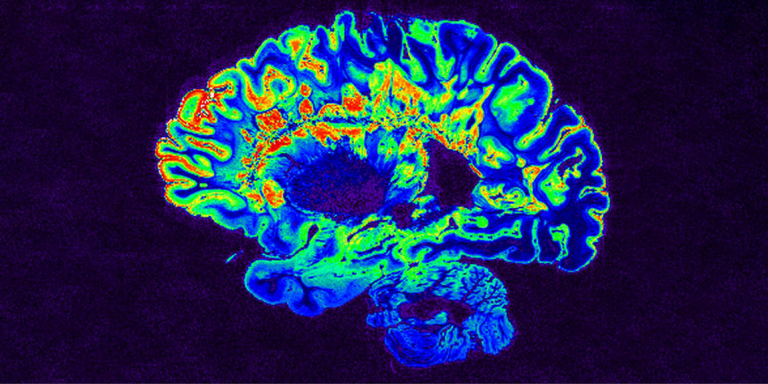
Multiple sclerosis (MS) is an autoimmune disease of the central nervous system (the brain and spinal cord). World MS Day 2022 was held on May 30. To diagnose it, doctors use a painless magnetic resonance imaging (MRI) scan of the brain and/or spinal cord. Deep learningcould allow doctors to make an earlier diagnosis and thus implement a more effective treatment to slow the progression of the disease.
Multiple sclerosis
Multiple sclerosis is an autoimmune disease characterized by the breakdown of myelin, the membrane that protects the axons of neurons. In concrete terms, the immune defense system, which is involved in the fight against bacteria and viruses, attacks the myelin, the protective sheath of the nerve fibers, disrupting communication within the nervous system and causing increasingly serious motor and neurological damage. 120,000 people are affected by MS in France, including 700 children, 3/4 of whom are women; 3,000 new cases are diagnosed each year, most often between the ages of 25 and 35.
Although MS cannot be cured, new treatments are now available to slow down the evolution of the disease, and they will be all the more effective if the diagnosis is made early, which is rarely the case.
Automating lesion detection using deep learning
The thesis ” Deep learning for big data in neuroimaging”, directed by Pierrick Coupé, CNRS research director at LaBRI (Laboratoire Bordelais de Recherche en Informatique), led by doctoral student Reda Abdellah-Kamraoui since 2019, is at the heart of these questions. Deep learning methods, developed for image recognition tasks, have been put to work to automate these complex and time-consuming operations to develop a new generation of quantitative MRI analysis methods that can cope with the rise of BigData in neuroimaging.
Reda Abdellah-Kamraoui explains:
“Early diagnosis of multiple sclerosis requires, among other things, MRI observation of biomarkers, such as lesions or abnormal volume of certain brain structures. Manually extracting this information from MRI images is time-consuming, so automatic techniques have been developed. “
He adds:
” Artificial intelligence (AI) remains a tool capable of being wrong. Doctors still have a monopoly on diagnosis. However, deep learning allows for an objective prediction, where two clinicians may not give the same interpretation. “
Generating fake images to train the algorithms
Deep learning requires a mass of examples and data to, in this case, train the algorithms to distinguish important features in MRI images. The problem encountered by Reda Abdellah-Kamraoui came from the fact that these elements are not standardized because the different MRI machines do not have the same rendering depending on their manufacturer and model. He therefore applied the generalization of neural networks, which allows to train the algorithms despite heterogeneous data.
In the same idea, part of his work has been devoted to the generation of synthetic images, he was able to overcome the lack of data to train the algorithms. In this context, Reda Abdellah-Kamraoui participated in the International Conference on Medical Image Computing and Computer Assisted Intervention (MICCAI), dedicated to medical imaging, on the detection and segmentation of new lesions due to multiple sclerosis.
He states:
“We needed to detect new lesions from two successive MRIs of the same patient. The concern is that since patients are treated as soon as lesions are identified, subsequent MRIs will not show significant differences and so we lack data to train our algorithms. We then proposed a technique where we generate fake MRI images that simulate the case of a patient who would not have been treated for several years, and then use them to train our AIs.”
He and his colleagues are also interested in predicting the MS severity score, again based on MRI images, but also on demographic and clinical data. This score is a very important parameter for the adaptation of treatment by doctors.
Automation of MRIs that can be generalized
For all this work, the team mainly uses the Python language and a dedicated library that allows algorithms to read MRIs. In addition to deep learning, the researchers are developing transfer learning, which allows an algorithm to master a new task thanks to skills learned from previous tasks. Indeed, systems based on artificial neural networks often have to start from scratch, or close to it, to learn a new task, even if it appears similar to the first.
In addition, this thesis work integrates the tools developed within the volBrain platform.
The volBrain platform
The study of MRI is not only about multiple sclerosis. Pierrick Coupé, Reda Abdellah-Kamraoui’s thesis supervisor, has thus created with Jose V. Manjón of the Polytechnic University of Valencia (Spain), the volBrain platform, which has 3,000 users worldwide and has already processed 140,000 MRI scans. This open access platform allows users to download MRI data and automatically perform many tasks useful for diagnosing neurodegenerative diseases such as MS, but also Alzheimer’s or Parkinson’s disease.
The integration of these solutions is carried out by Boris Mansencal, a research engineer at LaBRI. An ANR project, called DeepvolBrain, is currently underway to adapt the platform to the challenges of big data, due to the explosion in the size of MRI data. Physicians such as Thomas Tourdias, university professor and hospital practitioner at the Bordeaux University Hospital, are involved in the project.
Translated from Diagnostiquer la sclérose en plaques grâce à l’intelligence artificielle









